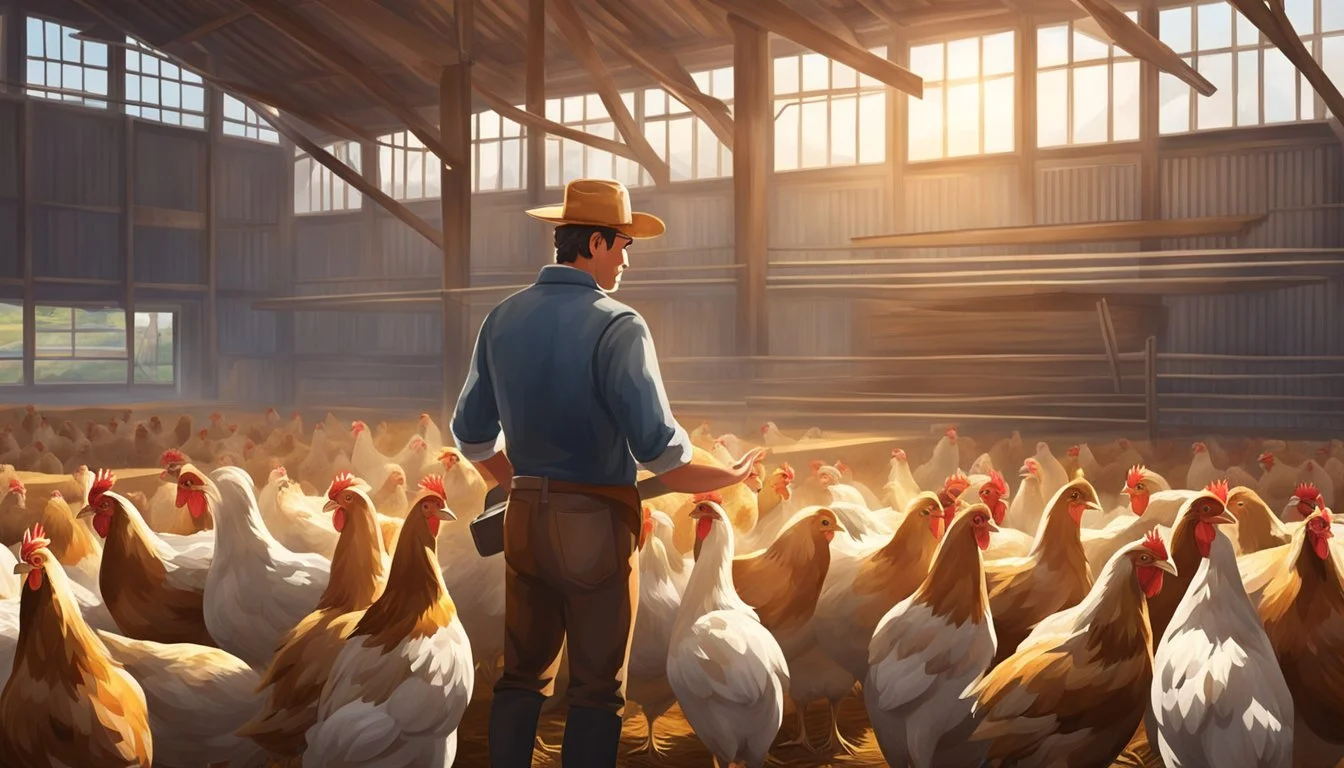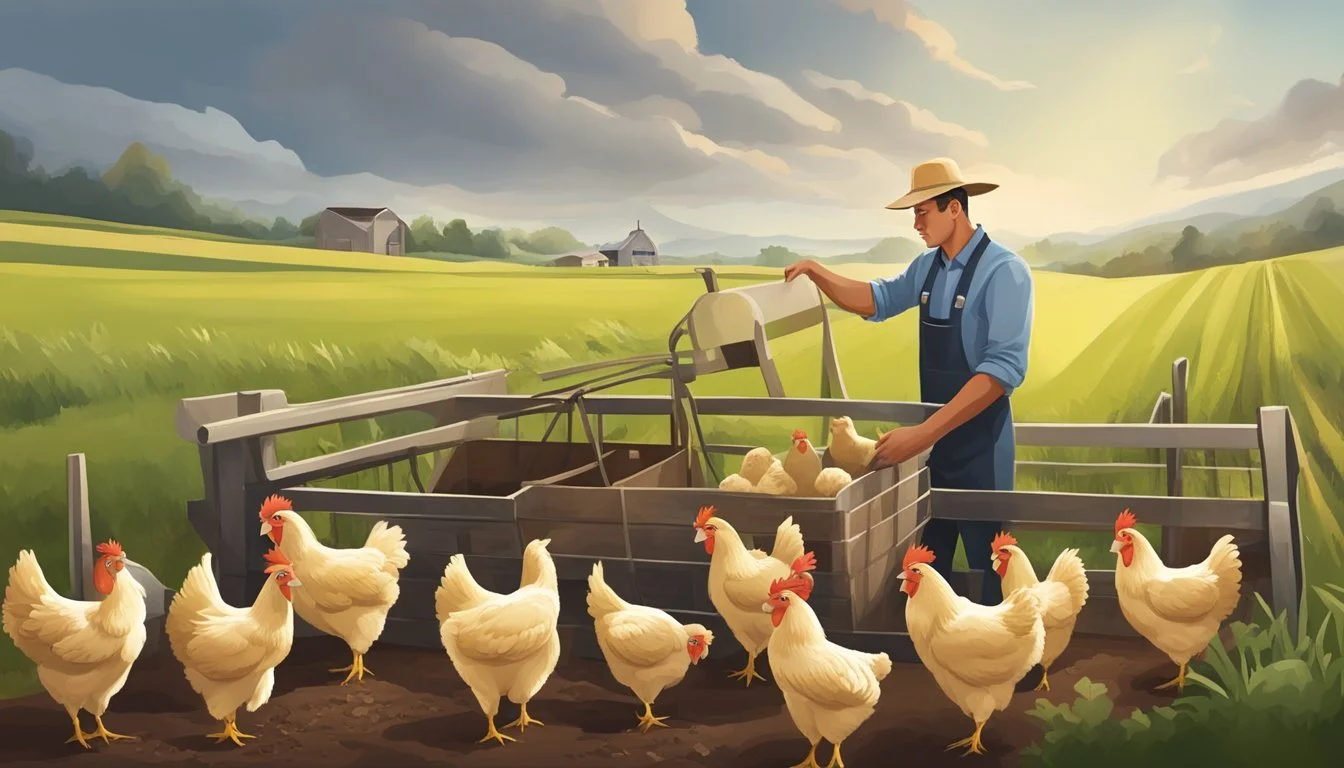What Are the Best Practices for Sustainable Chicken Farming?
Key Strategies for Eco-Friendly Poultry Agriculture
Sustainable chicken farming represents a method that amalgamates the need for producing sufficient poultry products and the necessity to maintain ecological balance. It is an approach to poultry farming that emphasizes soil health, biodiversity, and animal welfare, without compromising the ability to meet current food demands. Practices typical of sustainable farming principles include the provision of ample space for chickens, ensuring the presence of natural light, and allowing birds to exhibit natural behaviors, such as scratching and dust-bathing. These principles underline the importance of treating livestock ethically while also producing food in a manner that can be maintained over the long term without causing environmental degradation.
A key aspect of sustainability in chicken farming is the focus on environmental conservation, which involves responsible management of natural resources and minimizing waste. For instance, the management of chicken waste is critical to maintaining soil quality and preventing water pollution. Feed is also a crucial consideration in sustainable farming; utilizing organic feed free from synthetic fertilizers, pesticides, and GMOs ensures that the chickens are not ingesting harmful chemicals, which in turn prevents these substances from entering the ecosystem.
To implement sustainable practices effectively, farmers often follow comprehensive guides that provide best practices and actionable solutions for maintaining sustainability on the farm. This includes ways to optimize the health and growth of poultry flocks while significantly reducing the carbon footprint of farming activities. By committing to such practices, farmers contribute to the fight against climate change by sequestering carbon in the soil, further highlighting the interconnectedness of animal welfare and environmental stewardship in achieving overall sustainability in agriculture.
Understanding Sustainable Chicken Farming
Sustainable chicken farming incorporates practices that are environmentally friendly, economically viable, and ethically sound. Here we explore what sustainability means in the context of poultry farming, the positives of these methods, and address common challenges and misconceptions.
Defining Sustainability in Poultry Farming
Sustainability in poultry farming refers to approaches that meet the needs of the present without compromising the ability of future generations to meet theirs. It encompasses three main pillars: environmental health, economic profitability, and social responsibility. In practice, this means managing land and water responsibly, ensuring fair treatment and good welfare standards for the chickens, and maintaining economic stability for farmers.
Benefits of Sustainable Practices
Sustainable practices in poultry farming offer a multitude of benefits, from enhancing soil fertility and biodiversity to promoting animal welfare. Implementing these methods can lead to healthier poultry, which in turn can improve product quality. Moreover, sustainable agriculture practices can reduce overhead costs and enhance profitability in the long term through efficient resource use and by tapping into markets that value sustainably produced goods.
Environmental Stewardship: Mitigating the ecological impact by decreasing pollution and conserving water.
Profitability: Reduction in long-term costs through energy-efficient methods.
Animal Welfare: Providing a high standard of care to ensure the health and comfort of the chickens.
Challenges and Misconceptions
While sustainable chicken farming is gaining traction, it faces several obstacles. The initial investment for transitioning to sustainable practices can deter farmers. Additionally, there are misconceptions that sustainable methods are less productive or more labor-intensive. In reality, sustainable farming can be equally, if not more, productive while offering a holistic approach to managing poultry health, environmental care, and farm profitability.
Misconceptions: Sustainable methods are often incorrectly perceived as non-profitable.
Challenges: Farmers may encounter barriers such as lack of access to sustainable feeds or markets.
Key Elements of Sustainable Chicken Farming
Sustainable chicken farming prioritizes the well-being of the poultry, the efficiency of production, and the minimal impact on the environment. These key elements focus on the interplay between breed, feed, living conditions, and responsible resource management to ensure a healthy flock and a reduced ecological footprint.
Breed Selection and Genetic Management
The choice of breed is essential in sustainable farming as certain breeds are more suited to specific climates and farming systems. A pasture-based, regenerative system often prefers hardier breeds that can thrive in outdoor conditions. Genetic management also plays a significant role in supporting disease resistance and overall bird health.
Feed and Nutrition
A balanced diet is crucial for the productivity and health of chickens. Sustainable practices emphasize organic feed that is free from synthetic fertilizers, pesticides, and GMOs. This not only impacts the quality of chicken products but also supports a more natural growth cycle and reduces environmental pollutants.
Housing and Space Requirements
Proper housing is integral to sustainable poultry farming. It needs to provide ample space, natural lighting, and opportunities for chickens to engage in natural behaviors such as scratching and dust-bathing. Good housing design also contributes to efficient manure management and reduces the overall waste footprint.
Water Management
Sustainable water use is vital, and water management strategies include reducing waste and implementing recycling systems where possible. Clean, accessible water is important for chicken health and optimizing consumption can significantly reduce environmental strain.
Waste Management and Recycling
Responsible treatment and utilization of waste, including manure and litter, are pillars of sustainable chicken farming. Composting can transform waste into valuable organic fertilizer, reducing the need for chemical alternatives. Effective recycling practices reduce pollution and improve soil health, contributing to a closed-loop system.
Environmental Impact and Resource Management
Sustainable chicken farming practices focus on minimizing environmental impact and managing resources effectively. This includes reducing greenhouse gas emissions, maintaining soil health, and preserving biodiversity to create a balance between poultry production and ecological sustainability.
Reducing Greenhouse Gas Emissions
Greenhouse gas emissions remain a concern in poultry farming, with carbon dioxide, methane, and nitrous oxide as significant contributors. Implementing a pasture-based system can mitigate emissions by promoting natural behaviors and reducing the need for energy-intensive indoor environments. Studies suggest that optimizing feed and manure management can also lead to lower emissions, potentially lessening the sector’s contribution to climate change.
Soil Health and Land Usage
The health of the soil is critical for sustainable chicken farming, impacting land utility and resilience. Farmers utilize rotational grazing to prevent soil degradation and conserve resources. This practice supports the natural rejuvenation of the land and maintains fertility, ensuring that the land can continue to support chicken farming without significant artificial inputs.
Preserving Biodiversity and Ecosystems
Biodiversity and the health of ecosystems are vital for sustainable agriculture. Chicken farming should be conducted in a manner that respects native wildlife and plant species, integrating poultry production into the local environment without causing harm. For instance, maintaining buffer zones around farms can protect waterways and support diverse ecosystems, helping to reduce the environmental impact of farming activities.
Animal Health and Welfare
In sustainable chicken farming, safeguarding animal health and welfare is paramount. Practices must emphasize the physical comfort and behavioral needs of the chickens, ensuring that they lead healthy and stress-free lives.
Ensuring Animal Comfort and Welfare
Optimal animal welfare in poultry farming starts with comfortable and clean living conditions. This includes adequate space to prevent overcrowding, appropriate ventilation to maintain air quality, and consistent access to fresh water and nutritious feed. Temperature control is vital to keep chickens safe from extreme weather conditions, ensuring their comfort remains a top priority.
Natural Behaviors and Foraging
Chickens possess inherent natural behaviors, such as scratching and foraging, which are essential for their well-being. Sustainable practices encourage these behaviors by providing access to outdoor areas with appropriate vegetation and insects. Allowing chickens to engage in such activities promotes physical health and psychological satisfaction, thus supporting overall animal health.
Ethical Treatment and Husbandry Practices
Ethical and humane animal husbandry practices underscore the respect for the chickens' well-being. Routine health checks, preventative measures against disease, and the avoidance of unnecessary interventions like debeaking exemplify ethical treatment. Ethics in animal care also demand that any necessary interventions are carried out with minimal stress and discomfort to the animals.
Innovations in Sustainable Chicken Farming
The pursuit of sustainability in chicken farming has spurred a number of innovative practices aimed at reducing environmental impact while maintaining poultry health and productivity.
Technology and Farm Management
Recent advancements have led to the integration of technology in managing poultry farms more effectively. Precision farming techniques employ sensors and LED lighting to create optimal conditions for chickens to thrive. This not only improves animal welfare but also enhances productivity. Software systems enable farmers to monitor flock health in real-time, leading to early detection of potential issues.
Alternative Feeding Systems
A notable innovation in sustainable chicken farming involves the use of insects as a viable protein source. Insect farming requires less land and water than traditional feed crops, and insects can be fed on organic waste, reducing food waste in the process. Black soldier fly larvae, for example, are high in proteins and fats, making them an excellent feed supplement for chickens.
Energy and Water-saving Measures
Reducing water consumption and energy usage is paramount in sustainable poultry farming. Employing rainwater harvesting systems allows farms to collect and use rainwater for various operations, significantly lowering water bills and conserving water resources. Solar panels and insulation ensure efficient temperature control and energy use. These renewable energy sources lessen reliance on non-renewable resources and help in reducing the carbon footprint of the farming operation.
Regulations and Certifications
In the realm of poultry farming, adherence to regulatory standards and obtaining the relevant certifications are crucial for operational legitimacy and market trust. These certifications validate a farm's commitment to environmental stewardship and animal welfare.
Understanding Organic and Sustainable Certifications
Organic certifications for chicken farming ensure that processes adhere to stringent guidelines regarding feed, livestock health, and environmental impact. To be labeled as organic, farms must use 100% organic feed for their chickens, which excludes synthetic fertilizers, pesticides, genetically modified organisms (GMOs), or animal by-products. Furthermore, they must incorporate organic fertilizers in their farming practices, reinforcing a natural cycle of growth and sustainability.
Sustainable certifications, such as those promoted by the U.S. Roundtable for Sustainable Poultry & Eggs, focus on a broader scope that includes effective resource management, minimizing carbon footprints, and improving the local ecological balance. Farms seeking these certifications highlight their efforts in conserving water, energy, and other resources, ensuring the long-term viability of their operations.
Compliance with Local and International Standards
Farms must also align their practices with both local and international standards to maintain their certification status and to operate legally. This often means staying current with changes in regulations, such as the Organic Livestock and Poultry Standards (OLPS) set forth by governing bodies like the USDA.
These standards delineate clear requirements for livestock conditions, including adequate space, access to outdoor areas, and proper veterinary care. They serve to level the playing field for farmers and to promote fair markets. For global compliance, organizations must be aware of regulations like the European Union's organic standards, which can impact export capabilities and market access.
Market Dynamics and Consumer Preferences
The poultry sector is witnessing a shift as consumer preferences lean towards sustainable products. This trend impacts market dynamics, influencing the demand for various poultry goods, and comes with economic implications.
Demand for Sustainable Poultry Products
Consumers are increasingly seeking out sustainable poultry products such as ainable poultry pr and meat from turkey and chicken, with a special interest in organic chicken farming. This reflects a broader concern for animal welfare, the environment, and the desire for healthier food options. They are willing to explore products from dual-purpose breeds that are seen as more ethically raised and kinder to the environment.
Implications of Higher Prices for Sustainability
Sustainable poultry farming practices often lead to higher prices for the end products. Organic feed, increased space, and improved living conditions for the birds contribute to increased production costs. Although these practices align with consumer values, they need to balance their ethical preferences with their willingness to pay higher prices for poultry products like eggs and meat.
Economic Considerations and Business Planning
In sustainable chicken farming, careful economic considerations and business planning are paramount to achieving profitability. They ensure that the farm can be both economically viable and environmentally responsible.
Analyzing Profit and Cost
Sustainable chicken farming requires a meticulous analysis of both potential profits and associated costs. Farmers must account for the price of organic feed, which is often higher than conventional feed, but they should also factor in lower veterinary bills due to improved animal health from better farming practices. The economic benefits may also include lower water and energy usage due to efficiency measures.
Creating a Business Plan for Sustainable Operations
A detailed business plan is pivotal for the success of a sustainable poultry operation. This blueprint helps farmers structure the financial aspects of their business, identify market opportunities, and assess the risk against profitability. It should outline the initial investment costs, operating expenses, expected revenue, and projected cash flows over time.
Economic Benefits of Sustainable Farming Practices
Adopting sustainable farming practices offers notable economic benefits. Farmers who prioritize sustainability often experience increased long-term yields due to healthier soils and ecosystems. Additionally, there may be financial incentives or subsidies available for sustainable operations, and a growing consumer preference for ethically produced goods can potentially lead to premium pricing and increased market share.
Case Studies and Models of Success
In the realm of sustainable chicken farming, examining successful ventures and integrating the shared knowledge from these models can pave the way for wider adoption of environmentally friendly practices.
Examining Successful Sustainable Poultry Farms
Zimbabwe's Battle against Desertification: One of the prominent case studies in regenerative agriculture features a Zimbabwe farm reversing desertification. By integrating chickens into their regenerative system, the farm has not only revitalized their soil but also increased biodiversity.
Norwegian Crop Diversity: Another case of success comes from Norway, where poultry is strategically incorporated into crop rotations to enhance soil fertility, securing a more sustainable future for farm operations.
Lessons Learned and Best Practices
Sustainable Poultry Farming Techniques:
Rotation: Sustainable farms often use rotational grazing, which minimizes environmental impact and enhances soil quality.
Ethical Treatment: Ensuring bird welfare, such as providing ample space and natural behaviors, is pivotal as outlined in a guide to sustainable poultry farming practices.
Collaboration: Success in sustainable practices often hinges on collaboration among stakeholders, which has been shown to improve outcomes in sustainable agriculture as described in collaboration success cases.
Policy and Community Engagement:
Involvement of local communities and aligning with ethical considerations play a significant role in the efficacy and adaptability of sustainable farming methods.
Farms that engage in transparent practices and prioritize both animal welfare and environmental stewardship often find greater success and community support.
Looking Ahead: The Future of Sustainable Chicken Farming
As sustainable chicken farming practices evolve, they will increasingly impact global food security and offer diverse opportunities for innovation. These practices are instrumental in promoting an eco-friendly and socially responsible supply chain essential for our planet's health.
Emerging Trends and Opportunities
In the quest for more sustainable poultry production, notable trends include the integration of regenerative agricultural practices which emphasize the health of the soil and create a symbiotic relationship between the land and the animals. Mobile coops on pastureland are becoming more prevalent, allowing chickens to contribute to soil fertility through natural behaviors. Advances in technology are also paving the way for precision farming techniques that optimize resource use and minimize environmental impact.
The Role of Sustainability in Global Food Security
Sustainable chicken farming is pivotal in bolstering food security. Eco-friendly poultry practices ensure a stable supply of chicken meat and eggs, which are key protein sources for many populations. By adopting sustainable farming practices, farmers can reduce their ecological footprint, maintain higher levels of biodiversity, and support the resilience of food systems against the backdrop of a growing global population.
Long-term Vision for Sustainable Agriculture
Looking forward, the long-term vision for sustainable agriculture includes a holistic approach where sustainability and food systems coalesce. Initiatives such as cellular agriculture and vertical farming are likely to join more traditional methods, reducing the strain on land and creating a more robust, sustainable poultry supply chain. Aligning with environmental, economic, and social needs, these innovations could curtail overreliance on natural resources and foster a more equitable food distribution paradigm.








